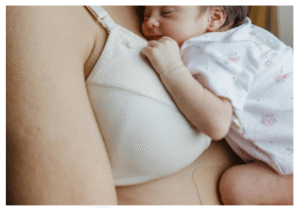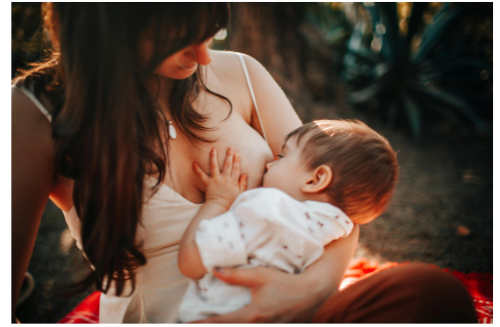If you’ve ever worried about whether breastfeeding might cause saggy breasts, you’re not alone. It’s one of the most common concerns new mothers share — and for good reason. Pregnancy changes the body in so many ways, and the idea of losing breast firmness can feel frustrating.
But here’s the good news: breastfeeding itself isn’t the main cause of saggy breasts. Let’s walk through the science, the myths, and the proven ways you can protect your body and confidence.
Does Breastfeeding Really Cause Saggy Breasts?
This is probably the #1 question moms ask — and the short answer is: No, breastfeeding does not directly cause saggy breasts.
Research shows that it’s pregnancy, not breastfeeding, that leads to changes in breast shape. During pregnancy, hormones cause your breasts to grow, milk ducts expand, and skin stretches. Whether or not you breastfeed afterward, your breasts may look different compared to before pregnancy.
A study published in the Aesthetic Surgery Journal found no direct link between breastfeeding and sagging — instead, factors like age, weight changes, and number of pregnancies were much more important.
What Actually Causes Saggy Breasts
Let’s break down the real culprits behind saggy breasts after pregnancy and nursing:
1. Aging & Gravity
As you age, your skin naturally loses elasticity and firmness. Gravity pulls breasts downward, especially if they’re larger.
2. Weight Fluctuations
Gaining and losing weight quickly can stretch the breast tissue and skin. This is common during pregnancy and postpartum.
3. Genetics
Some women are more prone to sagging simply because of their body’s natural collagen and skin structure.
4. Pregnancy (Not Breastfeeding)
During pregnancy, your breasts expand as milk-producing glands prepare. Even if you don’t breastfeed, these changes may cause sagging later.
When Sagging Is More Likely
Not every woman experiences noticeable sagging, but certain factors can make it more likely:
- Multiple pregnancies: Each pregnancy stretches the tissues further.
- Large breasts: Heavier breasts are naturally more affected by gravity.
- Smoking: Damages skin elasticity, speeding up sagging.
- Rapid weight loss after pregnancy: Can leave extra loose skin.
So while breastfeeding often gets the blame, it’s usually these factors working together.
Proven Ways to Prevent Saggy Breasts After Breastfeeding
Here’s the good part — while you can’t stop aging or change genetics, you can take steps to support your breast health and minimize sagging.

1. Wear Supportive Bras
A well-fitted bra provides proper support, especially during exercise and breastfeeding. Sports bras are great during workouts.
2. Maintain a Stable Weight
Fluctuations stretch the skin, so aim for gradual, steady postpartum weight loss. Crash diets can make sagging worse.
3. Exercise & Strength Training
You can’t exercise breast tissue itself (since it’s mostly fat), but you can strengthen the pectoralis muscles underneath. Push-ups, chest presses, and planks improve the overall lift of your chest.
4. Hydration & Skincare
Moisturize your chest area and drink plenty of water to keep skin elasticity strong. Ingredients like vitamin E and shea butter can help skin stay supple.
5. Good Posture
Standing tall with shoulders back instantly improves how your chest looks. Slouching makes breasts look lower than they are.
📖 EnhanceMedicalGroup on Preventing Breast Sagging
When to See a Professional for Saggy Breasts
If you notice:
- Significant breast asymmetry
- Sudden changes in breast texture or shape
- Lumps, dimpling, or pain
…it’s important to consult a doctor. Not all breast changes are due to pregnancy or aging. Sometimes they can be early signs of other health conditions.
If sagging bothers you for cosmetic reasons, you can also talk to a board-certified plastic surgeon about options like a breast lift.
Final Thoughts: The Truth About Breastfeeding & Breast Shape
So, does breastfeeding cause saggy breasts? The science says no. Pregnancy, genetics, aging, and lifestyle play a much bigger role than breastfeeding itself.
The best part? There are steps you can take to protect your breast health — from wearing supportive bras to exercising, hydrating, and keeping a stable weight.
Remember: every body changes after pregnancy, and those changes are a beautiful sign of the journey you’ve taken. If you’re ever worried about your breast health, don’t hesitate to reach out to a professional for reassurance.
At the end of the day, confidence matters more than perfection. Embrace the changes, take care of your body, and know that you’re not alone in this journey. 💙
This article was written and reviewed by the Info2Health Editorial Team. Our writers are passionate about health, wellness, and natural living. All content is fact-checked with reputable sources to ensure accuracy and clarity.
For more beauty topics click here
How to Fix Saggy Breasts
While you can’t change genetics or stop aging, you can take steps to keep your breasts looking firmer after nursing. Wearing supportive bras, maintaining a steady weight, staying active with chest-strengthening exercises, and keeping your skin hydrated all help protect breast shape. Even simple habits like good posture make a difference — small, consistent actions add up to long-term results.







